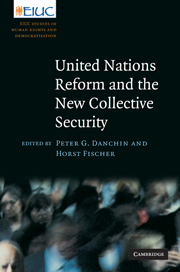Book contents
- Frontmatter
- Contents
- List of contributors
- Series editors' preface
- Preface
- List of abbreviations
- Introduction: the new collective security
- PART I Law and politics in United Nations reform
- PART II Defining “threats” to collective security
- PART III Prevention and responses
- 7 On the far side of conflict: the UN Peacebuilding Commission as optical illusion
- 8 The new peacebuilding architecture: an institutional innovation of the United Nations
- 9 The World Summit process and UN sanctions reform: between rhetoric and force
- 10 The UN response to the evolving threat of global terrorism: institutional reform, rivalry, or renewal?
- 11 International justice and collective security: between pragmatism and principle
- PART IV Perspectives on the ground
- Bibliography
- Index
8 - The new peacebuilding architecture: an institutional innovation of the United Nations
from PART III - Prevention and responses
Published online by Cambridge University Press: 05 May 2010
- Frontmatter
- Contents
- List of contributors
- Series editors' preface
- Preface
- List of abbreviations
- Introduction: the new collective security
- PART I Law and politics in United Nations reform
- PART II Defining “threats” to collective security
- PART III Prevention and responses
- 7 On the far side of conflict: the UN Peacebuilding Commission as optical illusion
- 8 The new peacebuilding architecture: an institutional innovation of the United Nations
- 9 The World Summit process and UN sanctions reform: between rhetoric and force
- 10 The UN response to the evolving threat of global terrorism: institutional reform, rivalry, or renewal?
- 11 International justice and collective security: between pragmatism and principle
- PART IV Perspectives on the ground
- Bibliography
- Index
Summary
Filling an institutional gap
The decision to create a new peacebuilding architecture was one of the key outcomes of the World Summit held at the United Nations Headquarters in September 2005. The prelude to that decision started with the report of the High-Level Panel on Threats, Challenges and Change which recommended the establishment of a Peacebuilding Commission within the United Nations. In the Secretary-General's In Larger Freedom report, that recommendation was slightly modified. The Secretary-General eliminated the High-Level Panel proposal to give the Peacebuilding Commission an early warning or monitoring function in conflict situations.
As a follow-up the to the World Summit, the General Assembly and the Security Council concurrently adopted identical resolutions in December 2005 establishing the Peacebuilding Commission, the Peacebuilding Support Office, and the Peacebuilding Fund. This new peacebuilding architecture is an important institutional innovation in the history of the United Nations. It builds on longstanding efforts by the United Nations, dating back to the 1992 report of the Secretary-General entitled “An Agenda for Peace,” to develop a coherent approach linking conflict prevention, peacemaking and peacekeeping to post-conflict peacebuilding and development.
While “An Agenda for Peace” made an important conceptual contribution to the debate on peacebuilding, the report of the Panel on United Nations Peace Operations (the Brahimi Report) provided additional impetus for the peacebuilding effort by highlighting its importance. The report also proposed the creation of a focal point for peacebuilding within the United Nations Secretariat, a reform that ultimately did not materialize.
- Type
- Chapter
- Information
- United Nations Reform and the New Collective Security , pp. 212 - 234Publisher: Cambridge University PressPrint publication year: 2010
- 2
- Cited by

